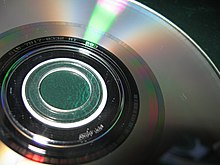GD-ROM
 | |
 The underside of a GD-ROM disc | |
| Media type | Optical disc |
|---|---|
| Capacity | 1.2 GB[1] |
| Developed by | Yamaha |
| Usage | |
| Optical discs |
|---|
GD-ROM (an abbreviation of "Gigabyte Disc Read-Only Memory") is a proprietary optical disc format originally used for the Dreamcast video game console, as well as its arcade counterpart, the Sega NAOMI and select Triforce arcade board titles. It was developed by Yamaha to curb piracy common to standard CDs and to offer increased storage capacity without the expense of the fledgling DVD-ROM. It is similar to the standard CD-ROM except that the pits on the disc are packed more closely together, resulting in a higher storage capacity of 1 gigabyte,[1] a 46% increase over a conventional CD's capacity of 700 megabytes.
The Dreamcast ended up being the only sixth-generation console with a disc based on CD technology rather than DVD technology; even the Nintendo GameCube's smaller 8 cm (3") discs held 20% more data due to being based on DVD technology. In addition, GD-ROM proved to be an ineffective anti-piracy measure when it was discovered the Dreamcast's forgotten MIL-CD functionality could be exploited to boot games burned to CD albeit with some content removed.
After the discontinuation of the Dreamcast worldwide on March 31, 2001, Sega continued to use the GD-ROM format in arcades with the Sega NAOMI 2, Triforce and Sega Chihiro. With the release of the Sega Lindbergh in 2005, Sega moved on to DVD discs and continued to use satellite and internet technology in the arcade. The last disc-based Naomi 2 and Triforce games were released in 2006 which marked the final releases using the GD-ROM format.
History[edit]
GD-ROM was developed as a collaboration between Sega and Yamaha, and first commercially appeared with the Dreamcast's Japanese launch in November 1998. The format was created in response to developers exceeding the storage capacity of the CD-ROM; while DVD-ROM would have addressed this limitation, implementing its then-new technology would have made console production cost prohibitive.[2] As a result, the Dreamcast was considered one of the most secure consoles on the market due to its copy protection and the GD-ROM's larger storage capacity compared to the CD-ROM;[3] however, this was nullified by a flaw in the Dreamcast's support for the MIL-CD format, a variant of the compact disc first released on June 25, 1999, that incorporates interactive visual data similarly to CD+G.[4][5] A hacker group self-named Utopia released their exploit in June 2000, having discovered that they could replace the visual data with Dreamcast code, enabling games burned onto recordable CDs to run on the console without any modding;[3][4] boot discs were initially used to facilitate this effort, but hackers subsequently discovered the ability to have burned games self-boot without the need for a boot disc.[3][6] As the GD-ROM format can hold about 1 GB of data, illegally copying Dreamcast games onto a 650 MB CD-ROM sometimes required the removal of certain game features, although this did not affect their playability.[3] Sega released a new revision of the Dreamcast hardware that removed MIL-CD support towards the end of 2000, closing its piracy loophole.[7][8][9] Games released around that time also began to incorporate a more robust copy protection system to thwart illegitimate use.[10]
Before the Dreamcast was released, Sega "confirmed that Dreamcast owners will one day be able to upgrade the GD-ROM drive to DVD" as part of its general expansion system to keep it competitive against more powerful contemporaries.[11] In June 1999, The Nihon Keizai Shimbun reported on the development of a DVD distribution system by Sega alongside Hitachi, Nippon Columbia, and an additional partner; one known planned use for it involved encrypted multi-title releases that were to be accessed via downloadable product keys.[12] Despite displaying a Dreamcast DVD display unit at E3 2000,[13] the plans for a DVD add-on or fully separate unit never materialized during the short production run of the Dreamcast, rendering it the only sixth generation console to not adopt the format.
GD-ROM was also made available as an upgrade for the Dreamcast's arcade cousin, Sega NAOMI and the later Sega NAOMI 2, providing alternate media to its cartridge-based software.[14][15] It is also used as an option on both the Sega Chihiro and Triforce, respectively based on the Xbox and GameCube consoles.[16][17]
Regions[edit]
Warnings[edit]
The second section (in conventional CD format) usually contains a message informing users that the disc can damage AV equipment. This is possible because a CD player can interpret the game data track as an audio track, which will result in loud noise being played through the speakers. Different discs, usually varying by region, contain different messages.
NTSC-U discs usually contain the message, "Warning: This disc is only for use on Sega Dreamcast.", "This disc is for use only on Sega Dreamcast." or "This is a Dreamcast game disc. The first track contains game data. Please, do not play it on a normal CD player." Some discs contain light-hearted or humorous messages from the game's characters (for example, Skies of Arcadia gives the message, "We can't save the world from a CD player, so just put us back in the Dreamcast so we can do our job!"). This is also common on NTSC-J discs.
PAL region discs contain the message, "This is a Dreamcast disc, and is for use only on a Dreamcast unit. Playing this disc on a hi-fi or other audio equipment can cause serious damage to its speakers. Please stop this disc now." The message is also repeated in French, German, Spanish and Italian. Some PAL region games, however, use the NTSC messages.
Technical information[edit]
The GD-ROM drive in the Dreamcast reads data in constant angular velocity (CAV) mode at up to 12× speed.[2]
See also[edit]
References[edit]
- ^ a b Johnston, Chris (February 1999). "Hands On: Dreamcast". Electronic Gaming Monthly. No. 115. Ziff Davis. p. 26.
- ^ a b Hagiwara, Shiro; Oliver, Ian (November–December 1999). "Sega Dreamcast: Creating a Unified Entertainment World". IEEE Micro. 19 (6): 29–35. doi:10.1109/40.809375.
- ^ a b c d Borland, John (June 30, 2000). "Hackers break Dreamcast safeguards, distribute games online". CNET. Archived from the original on October 29, 2014. Retrieved October 28, 2014.
- ^ a b Kohler, Chris (October 2005). "Retro-Hack the Dreamcast". Retro Gaming Hacks. O'Reilly Media. ISBN 9780596009175.
- ^ "First MIL CDs released in Japan". IGN. June 28, 1999. Retrieved June 15, 2024.
- ^ Carless 2004, p. 217
- ^ Carless 2004, p. 199
- ^ Gantayat, Anoop (January 16, 2001). "Sega Kills MIL CD Format". IGN. Retrieved June 10, 2024.
- ^ Zackheim, Ben (January 27, 2005). "The Dreamcast never dies". Engadget. Retrieved June 13, 2024.
- ^ Bramwell, Tom (January 18, 2001). "Sega Fights Piracy". Eurogamer. Retrieved June 15, 2024.
- ^ "Dreamcast Expandability" (PDF). Electronic Gaming Monthly. Vol. 122. Ziff Davis. September 1999. p. 204.
- ^ "Sega to Co-Develop DVD Technology for Use with Dreamcast?". IGN. June 8, 1999. Retrieved June 11, 2024.
- ^ Justice, Brandon (May 12, 2000). "E3 2000: First Look – Dreamcast DVD Player". IGN.
- ^ Gantayat, Anoop (September 20, 2000). "JAMMA 2000: Naomi 2 Revealed". IGN. Retrieved June 12, 2024.
- ^ "SEGA Arcade Continues Its Dominance". IGN. February 9, 2001. Retrieved June 12, 2024.
- ^ Gantayat, Anoop (September 19, 2002). "JAMMA 2002: First Look at Chihiro". IGN. Retrieved June 12, 2024.
- ^ Gantayat, Anoop (February 21, 2002). "AOU2002: First Triforce Game Footage". IGN. Retrieved June 12, 2024.
Bibliography[edit]
Carless, Simon (2004). Gaming Hacks. O'Reilly Media. ISBN 978-0-596-00714-0.
